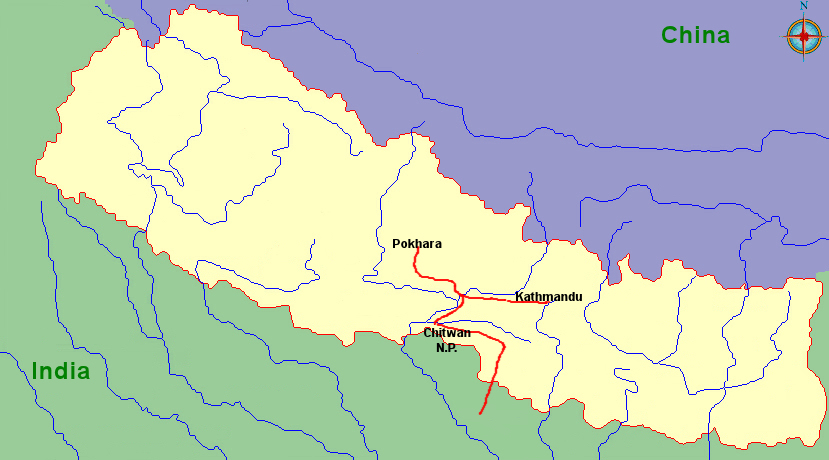Nepal

Historie
Neolithic tools found in the Kathmandu Valley indicate that people have been living in the Himalayan region for at least eleven thousand years.
The Gopal Bansa (1400 BC-700 BC) were likely one of the earliest inhabitants of Kathmandu valley. The earliest rulers of Nepal were the
Kiratas (Kirata Kingdom), peoples often mentioned in Hindu texts, who ruled Nepal from 900 BC to 300 AD.
Around 500 AD, small kingdoms and confederations of clans arose in the southern regions of Nepal. From one of these, the Shakya polity,
arose a prince who later renounced his status to lead an ascetic life, founded Buddhism, and came to be known as Gautama Buddha
(traditionally dated 563–483 BC).
By 250 BC, the southern regions had come under the influence of the Maurya Empire of North India and later became a vassal state under
the Gupta Empire in the 4th century AD.
The kings of the Lichhavi dynasty have been found to have ruled Nepal after the Kirat monarchical dynasty. The Licchavi dynasty went into
decline in the late 8th century, and was followed by a Thakuri era. Thakuri kings ruled over the country up to the middle of the 12th century
AD.
Beginning in the early twelfth century, leading notables in Nepal began to appear with names ending in the term malla, ("wrestler" in Sanskrit),
indicating a person of great strength and power. The Malla Dynasty ruled the Kathmandu Valley from 1201–1779.
After the death of Yaksha Malla in 1482, the Kathmandu Valley was divided up among his sons into three kingdoms of Bhaktapur,
Kathmandu and Patan.
The complete flowering of the unique culture of the Kathmandu Valley occurred during this period, and it was also during this time that the old
palace complexes in the three main towns achieved much of their present-day forms.
In the mid-18th century, Prithvi Narayan Shah, a Gorkha king, set out to put together what would become present-day Nepal. He embarked on his
mission by securing the neutrality of the bordering mountain kingdoms. After several bloody battles and sieges, notably the Battle of Kirtipur,
he managed to conquer the Kathmandu Valley in 1769.
The Gorkha control reached its height when the North Indian territories of the Kumaon and Garhwal Kingdoms in the west to Sikkim
in the east came under Nepalese control. A dispute with Tibet over the control of mountain passes and inner Tingri valleys of Tibet forced the
Qing Emperor of China to start the Sino-Nepali War (1788-1792) compelling the Nepali to retreat and pay heavy reparations to Peking.
Rivalry between the Kingdom of Nepal and the East India Company over the control of states bordering Nepal eventually led to the
Anglo-Nepali War (1815–16). The war ended in the Sugauli Treaty, under which Nepal ceded recently captured lands as well as the right
to recruit soldiers.
Factionalism inside the royal family led to a period of instability. In 1846, a plot was discovered revealing that the reigning queen had planned to
overthrow Jung Bahadur Kunwar, a fast-rising military leader. This led to the Kot massacre (14 september 1846); armed clashes
between military personnel and administrators loyal to the queen led to the execution of several hundred princes and chieftains around the country.
Jung Bahadur Kunwar emerged victorious and founded the Rana Dynasty, The king was made a titular figure, and the post of Prime Minister was
made powerful and hereditary. The Ranas were staunchly pro-British and assisted them during the Indian Rebellion of 1857 (and later in
both World Wars).
In 1923, the United Kingdom and Nepal formally signed an agreement of friendship that superseded the Sugauli Treaty of 1816.
Unsuccessful attempts were made to implement reforms and a constitution during the 1960s and 1970s. An economic crisis at the end of the 1980s led to
a popular movement which brought about parliamentary elections and the adoption of a constitutional monarchy in 1990.
The 1990s saw the beginning of the Nepalese Civil War (1996–2006), a conflict between government forces and the insurgent forces of the
Communist Party of Nepal.
Following an election held in 2008, the Nepalese Constituent Assembly formally abolished the kingdom in its first session on
28 May 2008, declaring the Federal Democratic Republic of Nepal in its place.
In 20 September 2015, a new constitution, the "Constitution of Nepal 2015" was announced by President Ram Baran Yadav in the constituent
assembly. The constituent assembly was transformed into a legislative parliament by the then-chairman of that assembly.
The new constitution of Nepal has changed Nepal practically into a federal democratic republic by making 7 unnamed provinces.
In October 2015, Bidhya Devi Bhandari was nominated as the first female president.
I visited Nepal in oktober 1992
These are the places I have seen on that trip
Royal Chitwan National Park
Pokhara
Kathmandu
Please let me know when you're having questions.
i would be pleased to help you.
Things to do and other tips
